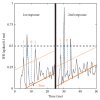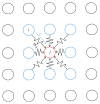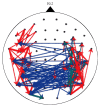Simulation of Code Spectrum and Code Flow of Cultured Neuronal Networks
- PMID: 27239189
- PMCID: PMC4863095
- DOI: 10.1155/2016/7186092
Simulation of Code Spectrum and Code Flow of Cultured Neuronal Networks
Abstract
It has been shown that, in cultured neuronal networks on a multielectrode, pseudorandom-like sequences (codes) are detected, and they flow with some spatial decay constant. Each cultured neuronal network is characterized by a specific spectrum curve. That is, we may consider the spectrum curve as a "signature" of its associated neuronal network that is dependent on the characteristics of neurons and network configuration, including the weight distribution. In the present study, we used an integrate-and-fire model of neurons with intrinsic and instantaneous fluctuations of characteristics for performing a simulation of a code spectrum from multielectrodes on a 2D mesh neural network. We showed that it is possible to estimate the characteristics of neurons such as the distribution of number of neurons around each electrode and their refractory periods. Although this process is a reverse problem and theoretically the solutions are not sufficiently guaranteed, the parameters seem to be consistent with those of neurons. That is, the proposed neural network model may adequately reflect the behavior of a cultured neuronal network. Furthermore, such prospect is discussed that code analysis will provide a base of communication within a neural network that will also create a base of natural intelligence.
Figures













Similar articles
-
Spike Code Flow in Cultured Neuronal Networks.Comput Intell Neurosci. 2016;2016:7267691. doi: 10.1155/2016/7267691. Epub 2016 Apr 27. Comput Intell Neurosci. 2016. PMID: 27217825 Free PMC article.
-
An integrate-and-fire model for synchronized bursting in a network of cultured cortical neurons.J Comput Neurosci. 2006 Dec;21(3):227-41. doi: 10.1007/s10827-006-7815-5. Epub 2006 Aug 31. J Comput Neurosci. 2006. PMID: 16951925
-
An extended model for a spiking neuron class.Biol Cybern. 2007 Sep;97(3):211-9. doi: 10.1007/s00422-007-0169-x. Epub 2007 Jul 24. Biol Cybern. 2007. PMID: 17647011
-
Statistical physics approaches to neuronal network dynamics.Sheng Li Xue Bao. 2011 Oct 25;63(5):453-62. Sheng Li Xue Bao. 2011. PMID: 22002236 Review.
-
The double queue method: a numerical method for integrate-and-fire neuron networks.Neural Netw. 2001 Jul-Sep;14(6-7):921-32. doi: 10.1016/s0893-6080(01)00034-x. Neural Netw. 2001. PMID: 11665782 Review.
Cited by
-
Learning process for identifying different types of communication via repetitive stimulation: feasibility study in a cultured neuronal network.AIMS Neurosci. 2019 Oct 16;6(4):240-249. doi: 10.3934/Neuroscience.2019.4.240. eCollection 2019. AIMS Neurosci. 2019. PMID: 32341980 Free PMC article.
-
Spike Code Flow in Cultured Neuronal Networks.Comput Intell Neurosci. 2016;2016:7267691. doi: 10.1155/2016/7267691. Epub 2016 Apr 27. Comput Intell Neurosci. 2016. PMID: 27217825 Free PMC article.
-
Effect of correlating adjacent neurons for identifying communications: Feasibility experiment in a cultured neuronal network.AIMS Neurosci. 2017 Dec 25;5(1):18-31. doi: 10.3934/Neuroscience.2018.1.18. eCollection 2018. AIMS Neurosci. 2017. PMID: 32341949 Free PMC article.
References
-
- Kliper O., Horn D., Quenet B., Dror G. Analysis of spatiotemporal patterns in a model of olfaction. Neurocomputing. 2004;58–60:1027–1032. doi: 10.1016/j.neucom.2004.01.162. - DOI
-
- Mohemmed A., Schliebs S., Matsuda S., Kasabov N. Training spiking neural networks to associate spatio-temporal input-output spike patterns. Neurocomputing. 2013;107:3–10. doi: 10.1016/j.neucom.2012.08.034. - DOI
MeSH terms
LinkOut - more resources
Full Text Sources
Other Literature Sources

